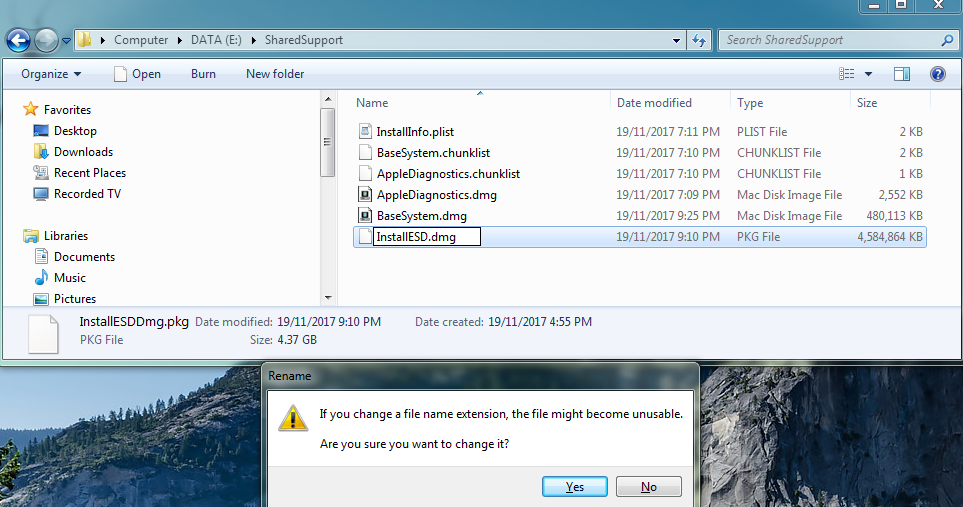
- #CREATE OS MAC SIERRA COPY BASE.SYSTEM MAC OS X#
- #CREATE OS MAC SIERRA COPY BASE.SYSTEM MAC OS#
- #CREATE OS MAC SIERRA COPY BASE.SYSTEM INSTALL#
- #CREATE OS MAC SIERRA COPY BASE.SYSTEM UPDATE#
In the Finder, copy your files to the mounted disk image, then eject it.įor more information about disk image types, see the manual (man) page for hdiutil. cdr file extension.ĭisk Utility creates the disk image file where you saved it in the Finder and mounts its disk icon on your desktop and in the Finder sidebar. dmg file extension.ĭVD/CD master: Changes the size of the image to 177 MB (CD 8 cm). Read/write disk image: Allows you to add files to the disk image after it’s created. Sparse disk image: Creates an expandable file that shrinks and grows as needed. Sparse bundle disk image: Same as a sparse disk image (below), but the directory data for the image is stored differently. To encrypt the disk image, click the Encryption pop-up menu, then choose an encryption option.Ĭlick the Partitions pop-up menu, then choose a partition layout.Ĭlick the Image Format pop-up menu, then choose an option: If the disk image will be used with a Mac or Windows computer and is 32 GB or less, choose MS-DOS (FAT) if it’s over 32 GB, choose ExFAT.
#CREATE OS MAC SIERRA COPY BASE.SYSTEM MAC OS#
If the disk image will be used with a Mac with macOS 10.12 or earlier, choose Mac OS Extended (Journaled) or Mac OS Extended (Case-sensitive, Journaled). If the disk image will be used with a Mac that has a solid state drive (SSD) and uses macOS 10.13 or later, choose APFS or APFS (Case-sensitive). In the Size field, enter a size for the disk image.Ĭlick the Format pop-up menu, then choose the format for the disk: This is the name that appears on your desktop and in the Finder sidebar, after you open the disk image. In the Name field, enter the name for the disk image.

This is the name that appears in the Finder, where you save the disk image file before opening it.

In the Disk Utility app on your Mac, choose File > New Image > Blank Image.Įnter a filename for the disk image, add tags if necessary, then choose where to save it. Browse to Contents/SharedSupport and copy InstallESD.dmg to your Mac user Downloads folder.You can create an empty disk image, add data to it, then use it to create disks, CDs, or DVDs. After downloading, right-click the installation file (located inside Applications) and choose show package contents.
#CREATE OS MAC SIERRA COPY BASE.SYSTEM UPDATE#
In this case, we will update the recovery partition on our MacBook Pro 2011 from the default 10.7 Lion recovery partition to the High Sierra recovery partition 10.13.6. On some older Mac’s, Internet recovery is done with key combo shift + option + command ⌘ + r. The exception are the Macs that originally shipped with a recovery DVD prior to Lion, or earlier Macs that lack the firmware update to boot into Internet Recovery. This means if you re-install Mac OS Lion 10.7 on a Mac that shipped with 10.7 and decide to upgrade to High Sierra, you will still have the Lion 10.7 Internet Recovery image. This is behavior controlled by the Apple servers and you will not be able to change the Internet recovery re-install image unless Apple decides too.
#CREATE OS MAC SIERRA COPY BASE.SYSTEM MAC OS X#
This boots to Internet Recovery mode and will only grab the version of Mac OS X that originally shipped with the Mac. Option + Command ⌘ + R (Internet Recovery):

#CREATE OS MAC SIERRA COPY BASE.SYSTEM INSTALL#
Is created by default when you install Mac OS X for the first time. This will attempt to boot from a recovery partition on your hard drive. For example, the 10.7 recovery partition does not include the same Terminal bash commands as High Sierra, such as csrutil. This can be frustrating in certain circumstances. Mac OS does not automatically update the recovery partition on Apple computers when you update the OS or re-install a new copy of the OS. In this guide, we will update a Mac’s old recovery partition (10.7 Lion or younger) to Mac OS High Sierra 10.13.5. These steps will fail and you will receive the following message:Įrror (async): The given disk has a storage system (such as AppleRAID) which is not supported for this operation (-69718) Note: You will not be able to install a recovery partition on an Apple RAID drive. After the script completes, you will have a recovery partition created.


 0 kommentar(er)
0 kommentar(er)
